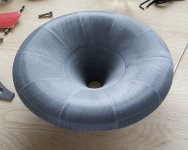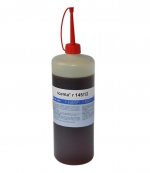Mine is recycled PLA from EkoMB. Prusa Mini just prints this great with standard profiles out of the box. I have not tried PETG yet, since I do not have the textures plate. CA glue bond is stronger than the plastic itself. I used the liquid nails for filling the gaps. The gaps can be filled later of course.
Done. The last petal was tricky, I almost didn't manage to squeeze it in because of the speed of the glue, that will require a different method. No filler yet, just sanded a bit.
For a battered brass, this is good enough. I can imagine doing a bigger one.
For a battered brass, this is good enough. I can imagine doing a bigger one.
Attachments
Last edited:
The thing is it's not warped, like at all. It would be much harder to make it from larger pieces (as virtually all ST260 prints so far were warped to a degree, it seems almost inevitable when doing it from halves).
The petals are still hollow. I will try to "cast" a polyurethane glue inside. It makes kind of a foam when wet. Or I will just leave them hollow...
The petals are still hollow. I will try to "cast" a polyurethane glue inside. It makes kind of a foam when wet. Or I will just leave them hollow...
Last edited:
With epoxy sand you need to be able to pack it in with a rod or similar if the print is hollow. I made up a batch to get a feel for how it handles. I used 80/20% sand/epoxy and it’s actually more epoxy than most research about epoxy granit or polymer concrete use. But it was not a pourable mixture in my case.
I'm not quite sure it's worth the effort but I may try something.
It's worth however odour free epoxy is pricey.
Not a problem (Epidian 652) but 3d print can leak epoxy be careful.
That is so true, even my solid walls will leak water if they are not first coated with a sealing layer of epoxy.
I would recommend a epoxy resin for thick pours/castings. They will have a longer curing time and produce less heat. This and the fact that the sand will act as heat sink with its large mass relative to the epoxy’s mass.
There is a patent for a speaker enclosure with hollow walls that is filled with polymer concrete like we are proposing here, and I will try to find it.
Edit: here it is https://patentimages.storage.googleapis.com/73/76/a3/f55a0ac84c9f8b/US4964482.pdf
Last edited:
I don't want to make it too complicated. The inner volume is only 2 - 5 mm thick in this case. My idea at the moment is to prepare a "foamy" PU glue by spraying water over it, mix it in a cup and inject into the petals with a syringe. Simple as that.
The proportions of this waveguide (ST260) are such that the petals are not a very prominent part of it, they are pretty small and light. Probably the easiest and also sufficient would be just to print them with infill and leave it as it is...
The proportions of this waveguide (ST260) are such that the petals are not a very prominent part of it, they are pretty small and light. Probably the easiest and also sufficient would be just to print them with infill and leave it as it is...
Last edited:
can I get the data?
now is not clear, what I can do.
I like to do not 3d-priting,
but CNC like Joseph Crowe Audio Products
now is not clear, what I can do.
I like to do not 3d-priting,
but CNC like Joseph Crowe Audio Products
Is going through the trouble of filling a hollow print like this worth the effort?
Don't many commercially available solid plastic waveguides get successfully used without worry of plastic resonance? Or is using waveguides without damping bad practice no matter the material? I know many metal horns use damping material so maybe plastic needs this as well?
How would printing these ST260/360/460 with 100% infill and applying dynamat type product to the back compare to filling hollow prints?
I'm just being lazy and trying to avoid unnecessary work.
Don't many commercially available solid plastic waveguides get successfully used without worry of plastic resonance? Or is using waveguides without damping bad practice no matter the material? I know many metal horns use damping material so maybe plastic needs this as well?
How would printing these ST260/360/460 with 100% infill and applying dynamat type product to the back compare to filling hollow prints?
I'm just being lazy and trying to avoid unnecessary work.
- Home
- Loudspeakers
- Multi-Way
- Acoustic Horn Design – The Easy Way (Ath4)


